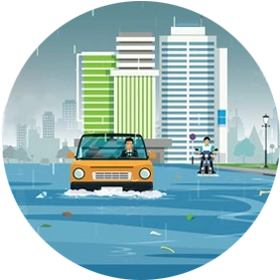Climate change impacts in Prague
In Prague, climate change has been manifested by air temperature increase, increase in urban heat island impacts and increased number of heat waves. According to climate models, the impact shall be even deeper in future. Annual precipitation totals are to be similar to current ones, but winter precipitation totals are predicted to increase, while summer ones are to decrease. The number of days without precipitation and that of drought period days shall significantly increase. Higher intensity and more pronounced extreme fluctuations in torrential rainfalls as well as frequency and length in the periods without precipitation and in droughts have also been projected. Frequency and intensity have also been increasing in other extreme weather events (e.g., thunderstorms, hailstorms or strong winds).
In the urban environment of the Capital City of Prague, these events are particularly related with following impacts:

Higher frequency in heat waves and their longer duration enhanced by the urban heat island effect.

Flash floods in small urbanized stream basins, supported by a high proportion parcels/plots with a quick surface rainfall water runoff.

Drought (hydrologic, biological/agricultural, socio-economic).
The design and implementation of appropriate adaptation measures can gradually mitigate these negative impacts and create acceptable living conditions for the inhabitants of Prague. More detailed data provided by the study Analysis and projection of climate change impacts in Prague, CzechGlobe 2016 are available at www.portalzp.eu.
If measures to improve microclimatic conditions in the affected areas are not step-by-step implemented, the following effects should be expected:
Extreme temperatures and lower air quality will pronounce heat wave impacts on human affecting larger areas and thus higher proportion of human population in the Capital City of Prague.
High temperatures and more frequent drought periods will negatively influence vegetation which will become degraded and will even step-by-step vanish in the periods characterized by lack of water.
Mitigating extreme temperature by air-condition is another source of anthropogenic heat also increasing a heat load in Prague.
For sensitive groups in the population, e.g. seniors/elderly citizens, babies/small children and sick persons, living and movement in a hot heated city will pose a health risk.
Flood risk including that of flash floods in small urbanized stream basins, supported by a high proportion of parcels/plots with a quick surface rainfall water runoff will be further increasing.
There will be more frequent longer drought periods strongly influencing water sources in watercourses and soils as well as underground water quantity. Lack of water can threaten providing inhabitants with drinking water and water abstraction for industry and irrigation.
High temperatures, drought and low water availability will negatively influence vegetation which will become degraded, thus worsening the unfavourable environment in Prague.

